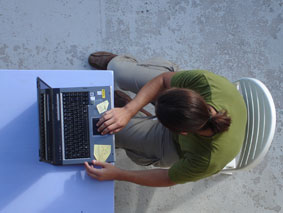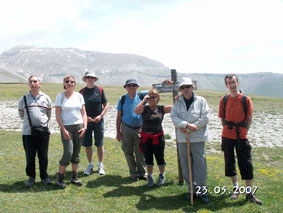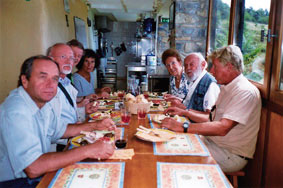|
Organisation : |
Université de Provence (Marseille) |
||||||||||||
|
Coordinateur : |
Paul Clavin, IRPHE |
||||||||||||
|
Dates : |
21 au 25 mai 2007 |
||||||||||||
| Participants : | Jean-Luc Willien, Catherine Cherfils, Javier Sanz (E), Yves Pomeau (F), Chantal Pomeau, Paul Clavin (F), Marie Christine Clavin, Josselin Garnier (F), Riccardo Betti (USA), Laurent Masse (F)¸ Christophe Almarcha (F), Hugues Egly (F), Emmanuel Villermaux (F), Patrice Le Gal, Laurent Duchemin (F), Jean-Luc Beaumont (F) | ||||||||||||
|
Les instabilités hydrodynamiques se manifestent dans de nombreux problèmes, notamment ceux qui sont associés à la production d’énergie. Avec le réchauffement global, la pollution et l’épuisement des réserves de gaz et de pétrole, le XXIème siècle sera confronté à de sérieux problèmes d’énergie. Le colloque 2007, qui a regroupé 18 participants, était consacré aux instabilités hydrodynamiques impliquées dans certain de ces problèmes.
La fusion nucléaire est une des solutions envisagées pour la production future d’énergie. Deux voies sont à l’étude, la fusion par confinement magnétique, programme mondial avec l’installation d’ITER à Cadarache et la fusion par confinement inertiel (FCI) qui fait l’objet d’importants programmes en France et aux États Unis et aussi d’un tout nouveau programme européen. La FCI a été un des objets du colloque :
• Dans une série de 4 conférences, le professeur Riccardo Betti de Rochester (USA) a exposé les problématiques des instabilités hydrodynamiques en FCI et les critères d’allumage des réactions nucléaires.
• Le professeur Javier Sanz de l’université polytechnique de Madrid a présenté une étude de l’effet du rayonnement sur la dynamique du front d’ablation.
• Le professeur Josselin Garnier de l’université de Paris VII a exposé une solution analytique de la dynamique du point chaud.
• Le docteur Laurent Masse du Centre à l’Énergie Atomique a développé une méthode originale, actuellement à l’étude au CEA, pour réduire les instabilités du front d’ablation.
• Messieurs Christophe Almarcha, étudiant en thèse à l’IRPHE (Marseille), et Hugues Egly, étudiant en thèse au CEA, ont présenté leurs résultats sur la modélisation mathématique de la dynamique du front d’ablation.
Trois autres sujets ont été abordés :
• Le professeur Emmanuel Villermaux de l’université de Provence (Marseille) a présenté une série de travaux expérimentaux et théoriques sur les fronts minces accélérés
• Le professeur Yves Pomeau de l’École Normale de Paris et de l’université d’Arizona a donné une conférence sur la formation des singularités dans les solutions des problèmes hyperboliques non linéaires avec application au déferlement des vagues.
• Le professeur Paul Clavin de l’université de Provence (Marseille) a développé les résultats d’une étude récente sur la structure des flammes avec application à la combustion de l’hydrogène qui est un des enjeux du futur.
Le site enchanteur du village de Peyresq reste un lieu sans égal pour regrouper quelques scientifiques motivés et leur permettre de se rencontrer, travailler et réfléchir ensemble sur des thèmes d’avenir.
|
Organisation : |
Institut Non Linéaire de Nice (INLN) |
|
Coordinateurs : |
Freddy Bouchet et Jean-Luc Beaumont |
|
Dates : |
28 mai au 1er juin 2007 |
|
Participants : |
Arnaud ANTKOWIAK, Médéric ARGENTINA, Julien BARRÉ, Jean-Luc BEAUMONT, Freddy BOUCHET, Arezki BOUDAOUD, Nicolas CLAUVELIN, Anne DE BOUARD, Fabien DROUART, François GALLAIRE, Lionel GIL, Christophe GIRAUD, Pierre GODARD, Geoffroy GUÉNA, Sylvain JOUBAUD, Eytan KATZAV, Martine LE BERRE, Martin LENZ, Henri LHUISSIER, Xavier NOBLIN, Franck RAYNAUD, Jacq.-Alex. SEPULCHRE, Miguel TREJO, Antoine VENAILLE, Emmanuel VILLERMAUX et Ibtissame ZAITER |
Avec son thème général "Instabilités et structures", les Rencontres de Peyresq 2007 se situèrent pleinement dans la continuité des écoles thématiques d'été précédentes tenues à Peyresq : 3 cours de 5 heures et 2 cours de 3h furent dispensés par 5 intervenants qui firent preuve de grandes qualités pédagogiques.
Le cours “Locomotion animale dans les fluides” [5h] par Médéric ARGENTINA, fut l’occasion de montrer toute la diversité des phénomènes physiques mis en jeu pour la locomotion des animaux. Les principes physiques qui permettent le déplacement varient suivant le milieu dans lequel évolue l’organisme. Dans ce cours, nous avons étudié quelques modes de locomotion dans les fluides. Nous nous sommes intéressés en particulier aux modes de déplacement de micro-organismes qui ne ressentent pas les effets de l’inertie. Pour de plus gros organismes, comme pour les poissons, l’inertie devient nettement plus importante et la physique responsable du déplacement s’en trouve fortement modifiée. Nous avons détaillé les différents types de locomotion pour de tels organismes.
Le cours “La physique non-linéaire à travers les plaques élastiques” [5h] par Arezki BOUDAOUD fut l’occasion d’un rappel des notions de bases de l’élasticité, suivi d’un cours d’une qualité pédagogique remarquable sur des applications modernes et passionnantes de cette vieille théorie. Manipuler une feuille de papier laisse entrevoir une grande richesse de comportements et de formes, qui a suscité nombre de travaux depuis une dizaine d’années. En fait, la physique d’une plaque élastique illustre de nombreuses facettes de la physique non-linéaire, qui ont été explorées lors de ce cours :
• motifs en bandes et instabilités secondaires lors du flambage de plaques ;
• singularités et focalisation de l’énergie dans les plis d’une feuille ;
• cascade d’énergie de grande échelle à petite échelle dans une feuille froissée.
Le cours “Solitons dans des fibres optiques couplées” [3h] par Martine LE BERRE (Laboratoire de PhotoPhysique Moléculaire-LPPM, Université Paris-Sud et CNRS) considéra des avancées récentes dans la physique des solitons. Les solitons se propagent dans les fibres optiques sur de très grandes distances depuis le début des années 80. Martine a détaillé la dérivation de NLS à partir des eqs. de Maxwell pour décrire la propagation d’un soliton. Puis nous avons étudié le cas de deux fibres couplées linéairement : la théorie classique prévoit que seule la solution a-symétrique est stable a faible couplage, l’intensité du soliton étant presque entièrement localisée dans l’une des deux fibres. Nous avons repris ce problème, en considérant l’effet tunnel quantique, i.e. le passage d’une fibre à l’autre, grâce aux fluctuations quantiques du nombre de photons dans le soliton. Le traitement semi-classique, par la méthode WKB nous a permis de montrer que l’effet tunnel devrait être observé dès que la durée du pulse est supérieure à quelques picosecondes.
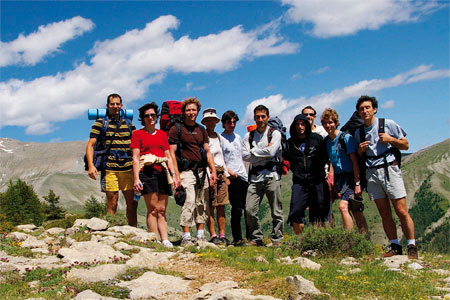
Le cours “Influence de perturbations stochastiques dans les équations de Schrödinger Non Linéaire” [3h] par Anne DE BOUARD (Laboratoire de Mathématiques, Université Paris-Sud et CNRS) considéra lui aussi les propriétés des solitons. Les phénomènes de propagation d’ondes, et notamment d’autofocalisation dans certains systèmes moléculaires soumis à des fluctuations dues à la température — comme par exemple certains films moléculaires minces — sont modélisés à l’aide de systèmes d’équations discrètes contenant des perturbations stochastiques, qui dans la limite continue conduisent à des équations de type NLS stochastiques. Nous avons étudié l’influence de différents types de perturbations stochastiques, toujours de la forme bruit blanc (delta-corrélé) en temps, notamment sur le collapse des ondes et sur la propagation des solitons. Nous avons vu, à l’aide de l’étude théorique des modèles, mais également de simulations numériques, de quelle manière la dynamique dépend de la longueur de corrélation spatiale des perturbations.
Le cours “Dynamique d’interface et fragmentation” [5h] par Emmanuel VILLERMAUX et Arnaud ANTKOWIAK aborda les phénomènes de fragmentation des bulles de gaz dans un liquide, des jets, etc. Une attention particulière fut apportée à tous les processus possibles pour la formation de gouttes en général. De nombreuses observations ont été rassemblées pour proposer une vision unifiée de la transformation d’un volume de liquide en un ensemble de gouttes de tailles différentes.
Ces cours ont été suivis par une trentaine d’auditeurs, environ. Cette édition s’est déroulée dans une très bonne atmosphère, et a débouché sur de nombreuses réflexions et discussions collectives.
| Organisation : | Jean Dhombres |
| Coordinateur : | Jean Dhombres |
| Dates : | 4 au 8 juin 2007 |
| Participants : | Jean Dhombres, Laurent Clauzade, Yann Clément, Pierre Lamandé, Vincent Jullien, Laurent Fedi, Félix Agid, Carlos Alvarez, Eduardo Canaiollo, Rafaël Martinez, Jean-Claude Martzloff, Hamde Mlika, François Loget, Hugues Chabot, Lucien Ovalabib |
Du 4 juin au 8 juin 2007, un colloque d’environ 25 philosophes, historiens et scientifiques, intitulé “Humanismes, mathématiques, positivismes”, s’est déroulé à Peyresq dans les magnifiques installations du foyer d’humanisme Nicolas-Claude Fabri de Peiresc.
Si le prétexte formel en était le 150e anniversaire de la disparition d’Auguste Comte, fondateur du positivisme, l’occasion trouvée était un discours prononcé à Ratisbonne par un ancien professeur de théologie de cette université, devenu pape, où étaient réunis les trois mots : humanisme, positivisme et mathématique.
L’un des arguments de nature historique de ce discours avançait que la conjugaison des mathématiques et du positivisme issu des Lumières avait conduit à une déchéance de l’humanisme. Il valait la peine, en passant au pluriel pour chacun des trois mots, de réfléchir plus largement à partir d’un lieu commun presque intemporel qui fait des mathématiques une science “inhumaine”. Comme il n’était pas inutile de détruire la vision trop ordinaire du positivisme comme philosophie ne donnant validité qu’à la démarche mathématique, à l’exclusion des autres formes de pensée. Cette fausse interprétation nourrit l’accusation contre le positivisme de faire relever la morale de la seule subjectivité et la religion de l’arbitraire. On retrouve dès lors l’accusation contre la philosophie de pervertir le jeu social. L’occasion était aussi belle de faire une histoire de la peur des mathématiques, quelquefois associée à des moments historiques de l’humanisme.
Les Actes de ce colloque devraient paraître dans le premier semestre 2008 dans la revue internationale d’histoire et de philosophie des sciences, Sciences et Techniques en Perspective, diffusée par Brepols (Begijnhof 67, B-2300 Turnhout). C’est dans cette revue que furent publiés en effet les Actes d’un précédent colloque consacré à Peiresc (1604-2004)(STP, 9, fasc. 1, 2005, 446 pages).
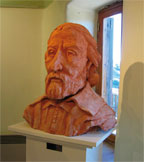 Nicolas-Claude Fabri de Peiresc. Buste à la salle Vinci de Peyresq, Adrien Versaen.
Nicolas-Claude Fabri de Peiresc. Buste à la salle Vinci de Peyresq, Adrien Versaen.|
Organisation : |
Institut Fourier, Université Joseph Fourier, Grenoble |
|
Coordination : |
Frédéric Faure |
|
Dates : |
4 au 10 juin 2008 |
|
Participants : |
Pierre Albin et sa compagne Kay Kirkpatrick, Frédéric Faure, Colin Guillarmou, Michael Hitrik, Maurice Lombardi, Gabriel Rivière, Nicolas Roy et sa famille, Emmanuel Schenk, Johannes Sjostrand, Dominique Spehner et San Vu Ngoc. |
Cette rencontre s'est déroulée sous la forme d'un groupe de travail, autour d'un thème précis (mais assez général car il se retrouve dans plusieurs domaines de la physique mathematique) : "Les résonances en physique et mathématiques", "approches semi-classiques et operateurs non auto-adjoints".
L'objectif était la compréhension de travaux récents et l'exploration de nouvelles pistes à travers des exposés, discussions et travaux en petits groupes.
Les deux premiers jours, il y a eu 3 exposés suivis de longues discussions ouvertes, où nous avons dégagé des idées nouvelles.
A l'issue de ces deux jours, nous avons sélectionné deux questions qui semblaient nouvelles, simples et abordables pour les trois jours restants. Nous nous sommes répartis en deux groupes et chaque groupe a exploré son problème. En fin de journée, nous faisions un compte rendu devant tout le monde.
Cela s'est très bien passé. Il y a eu des avancées significatives sur les problèmes abordés et les participants étaient tous ravis, à la fois par l'échange scientifique mais aussi par la qualité de l'accueil à Peyresq et la beauté du cadre.
Au moins deux publications vont voir le jour, comme conséquence directe de notre travail lors de cette semaine :
• "Spectra and semigroup smoothing for non-elliptic quadratic operators"
Auteurs : Michael Hitrik et Karel Pravda-Starov
• "A semiclassical approach for Anosov Diffeomorphisms and Ruelle resonances"
Auteurs : F. Faure, N. Roy et J. Sjöstrand.
Tout le monde a beaucoup apprécié le séjour, du à la qualité des personnes de l'accueil, la beauté exceptionnel du site et la quiétude du village, et aussi les moments de détente: musique, marche...
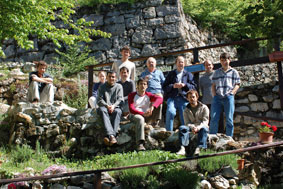 |
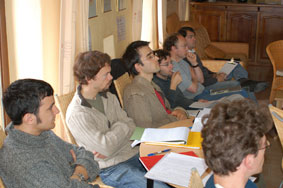 |
|
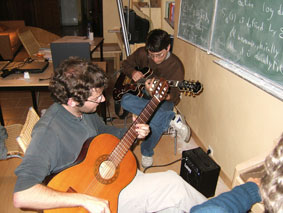 |
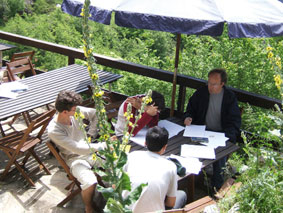 |
|
|
Organisation : |
Université de Maryland, Université de Barcelone, Université Libre de Bruxelles |
|
Coordination : |
Bei-Lok Hu, Ted Jacobson et Edgard Gunzig |
|
Dates : |
16 au 22 juin 2007 |
|
Participants : |
Edgard Günzig, Valeri Frolov, Bill Unruh, Renaud Parentani, Don Marolf, Brandon Carter, Misha Volkov, Don Page, Gregory Gabadadze, Cédric Deffayet, Diego Blas, Steve Carlip, Ted Jacobson, Albert Roura, Guillem Pérez-Nadal, Larry Ford et Bei-Lok Hu |
| Publication : | Les “Abstracts of the talks” de Peyresq Physics 12 seront édités dans un numéro spécial du “International Journal of Theoretical Physics” (USA) |
Nous sommes arrivés à Peyresq le mardi 19 juin en fin d’après-midi. Le soir même à 22 heures 29 min, ô hasard du calendrier, nous avons pu observer le passage au-dessus de nos têtes, de la Station Spatiale Internationale (ISS) et de la navette spatiale. Deux satellites très brillants (magnitude -1, autant que Vénus elle-même) se suivant comme reliés par un câble … mais seulement sur la même orbite et voguant de concert distants d’environ 1°, soit environ une centaine de kilomètres, avant une phase de contact.
Les organisateurs de ce congrès annuel sont Edgard et Diane Gunzig. Il s’agissait de la 12ème rencontre à Peyresq de quelques-uns des plus grands théoriciens de cosmologie et physique théorique mondiaux ! Il y a 13 ans, Edgard Gunzig, lui-même cosmologiste de renom, de l’Université Libre de Bruxelles, qui travaillait avec quelques collègues, leur propose de continuer la discussion, ailleurs … Quelques autres cosmologistes de Paris se joignent à eux et c’est dans ce petit village de Haute-Provence que ces rencontres vont commencer. Edgard et Diane vont d’abord créer une Fondation pour la Recherche Fondamentale (OLAM) en un temps record de 12 à 15 mois ; celle-ci deviendra une Association pour la Recherche Fondamentale (loi 1901). L’année suivante, tout a continué, puis l’association a monté en puissance.
La caractéristique essentielle de ce congrès, c’est d’abord le nombre limité de ses participants, entre 15 et 20, nombre qui s’est révélé optimum au cours des années vu l’infra structure locale … Il n'y a pas d’hôtel à Peyresq. Ce nombre limité de participants permet une beaucoup plus grande spontanéité dans les discussions, qui durent le soir et parfois, jusqu’à tard dans la nuit. Les physiciens restent regroupés ; il faut dire que le village, situé à 1500 mètres d’altitude, ne compte que quelques dizaines de maisons, que la route se termine ici en cul de sac et qu’il faut une demi-heure, en voiture, pour descendre à la petite ville d’Annot. Pas de passage de voitures, pas de curieux… un paradis pour physiciens théoriciens en somme !
Chaque journée comporte quatre exposés ; à chaque fois un physicien fait une présentation avec “PowerPoint” d’un sujet portant sur sa recherche ; l’intervention est beaucoup moins formelle que dans un congrès conventionnel, où le temps de parole est souvent limité à 20 minutes ; là les exposés durent plutôt une heure trente minutes, souvent interrompus par les autres cosmologistes, qui posent une question, ou bien font part de leur sentiment sur un point particulier, ou discutent sur un résultat de recherche de leur collègue sur lequel ils ont une vue différente…
Comme nous le commente Monsieur Gunzig, une grande qualité est atteinte depuis 6 ou 7 ans. Grâce à quelques collègues Américains, Canadiens et Espagnols participants, ces rencontres de Peyresq, commencent à être connues, mais “pas trop”, car il ne faut pas que la demande devienne explosive par rapport aux capacités d’accueil du petit village … Par exemple, il n’y a pas lancement d’information sur internet.
Un congrès est bon s’il apporte une “valeur ajoutée” ; les Rencontres de Peyresq ne sont pas là pour faire part des dernières découvertes ; les participants, qui viennent avec leurs conférences, ont déjà publié leurs travaux, dans la littérature spécialisée. Comme le dit Edgard Gunzig, on n’est pas là pour apprendre, l’essentiel est dans la rencontre prolongée des participants, la vie partagée pendant une semaine ; des collaborations internationales sont ainsi nées, qui n’auraient pas eu lieu sans cela.
Remarquons aussi, les annales de ce congrès, paraissent dans un numéro spécial d’ IJTP (International Journal Theorical Physics) qui leur est totalement dédié ; la longueur des articles est à la discrétion des auteurs, alors qu’habituellement les textes dans ces journaux spécialisés sont très “formatés”.
Que Diane et Edgard Gunzig qui nous ont offert le couvert et permis d’assister aux conférences et interview de quelques cosmologistes par un journaliste de “La Recherche” soient ici vivement remerciés pour leur gentillesse.
- Dominique Glasson
- Les "Abstracts of the talks"
- Diego Blas
Departament de Física Fonamental. Universitat de Barcelona. E-mail: dblas@ffn.ub.es
Unimodular gravity and spin 3/2
It has been recently shown that there exist two non-equivalent Lagrangians that give rise to the equations of motion of bosonic massless particles of spin s ≥ 2. The new Lagrangians are related to the standard ones by partially fixing the gauge already at the Lagrangian level. The structure of constraints then imply a new tertiary constraint that makes possible that both Lagrangians have the same equations of motion except for an integration constant. One natural question is whether a similar behaviour occurs in the case of spin 3/2 whose standard Lagrangian has also a gauge symmetry. One can show that this is not the case and that in this case there is also a propagating degree of
freedom of spin 1/2.
However, once we couple the standard Rarita-Schwinger Lagrangian to a conserved source, this new degree of freedom is also present (this is a usual feature of gauge theories). Furthermore, the propagator of both the Rarita-Schwinger Lagrangian and that of its partially gauge fixed counterpart is the same at tree-level. Thus, we conclude
that both theories are equivalent once we have the same initial conditions. There is a difference, however, in the fact that for the standard RS case this initial conditions must satisfy certain constraints whereas in the partially gauge fixed case they are free. The fact that the new Lagrangian is partially gauge fixed allows to couple the system to a
electromagnetic field without the algebraic inconsistencies that appear for the RS case.
Besides, we can try to extend the partially gauge fixed Lagrangian of spin 2 (or unimodular) to a supersymmetric Lagrangian. One can show that this is not possible already at the linear level. Nevertheless, if we consider the standard coupling of the usual RS Lagrangian to the unimodular Lagrangian, we find that the integration constant A cancels even if the system is not supersymmetric. This surprising fact can be important for the cosmological constant problem in this setup.
Steve Carlip
Department of Physics. University of California. E-mail: carlip@physics.ucdavis.edu
Black hole thermodynamics from Euclidean horizon constraints
Black holes behave as thermodynamic systems, with characteristic energies and entropies. The entropy of a black hole depends on both Planck’s constant and Newton’s constant, and one might hope that an understanding of the underlying microscopic states could give us insight into the difficult problem of quantizing gravity. Today, though, we suffer an embarrassment of riches – many different microscopic pictures, from string theory, loop quantum gravity, and other approaches, all give the same entropy while counting very different microscopic states. I discuss the possibility that this “universality” reflects an underlying symmetry near the black hole event horizon. I show that such a symmetry, when combined with constraints that ensure the presence of a black hole, can in fact yield the correct black hole entropy, and that this same symmetry is hidden in at least one string theory calculation. I describe a possible “effective” description of the relevant degrees of freedom as states coming from the breaking of the symmetries of general relativity by the presence of a black hole horizon.
Brandon Carter
Laboratoire de l’Univers et de ses Théories. Observatoire de Paris-Meudon. E-mail: brandon.carter@obspm.fr
Vortons as string loops
The term vorton was introduced to designate centrifugally supported loop configurations of cosmic strings, as constituted on a microscopic scale by vortex type topological defects of classical field models. At the level of a complete field theoretical description little is known about the existence and stability of such toroidal equilibrium state. It is however possible to provide a reasonably complete account of the existence and stability of vorton equilibrium states at the macroscopic level of a (two dimensionally supported) thin string description in which the (conceivably destabilising) internal defgrees of freedom are neglected.
Cédric Deffayet
Institute d’Astrophysique de Paris. E-mail: deffayet@iap.fr
Some issues about static spherically symmetric solutions of massive gravity
There is a raising interest for theoretical constructions where gravity is modified at very large, i.e. cosmological, distances. These constructions are mostly aiming at explaining the observed acceleration of the expansion of the Universe without the need for a non vanishing dark energy component in the Universe. They encompass models of
so-called massive gravity, in the broad sense, such as the so-called Dvali-Gabadadze-Porrati (DGP) model. However, these models are non devoted from various possible inconsistencies, and it is of crucial importance to better understand them. In this talk, I will review some properties of a particular class of solutions of these models: the static spherically symmetric solutions, which shed some light on various properties and possible inconsistencies of those constructions.
Larry Ford
Physics and Astronomy Department. Tufts University. E-mail: ford@cosmos.phy.tufts.edu
Enhanced black hole horizon fluctuations
Hawking’s original derivation of black hole evaporation relies upon extremely high frequency modes. In this picture, the modes which will become occupied midway through the evaporation process hover very close to the horizon for a long time. In particular, they are much less than a Planck length outside the horizon in an infalling observer’s frame. Here we address the issue of whether quantum fluctuations can upset this picture.
Previous work indicated that the natural vacuum fluctuations may not be large enough to alter the outgoing modes until the black hole reaches the Planck mass. We examine the effects of enhanced fluctuations due to matter or gravitons in a highly squeezed vacuum state falling across the mean horizon. Preliminary results suggest that these enhanced fluctuations can be large enough to upset the Hawking picture and potentially leave an imprint on the outgoing radiation.
Valeri Frolov
Theoretical Physics Institute. University of Alberta. E-mail: frolov@phys.ualberta.ca
Hidden symmetries and separation of variables in higher ddimensional black holes
An idea that the spacetime may have more than 4 dimensions is very old. Higher dimensions naturally arise in the string theory as the condition of its consistency. Usually it is assumed that all the dimensions except the physical ones are compact with a natural scale of the compactification of the order of the Planckian scale. This make it extremely difficult to check experimentally the existence of extra dimensions. Recently there were proposed models in which the size of extra dimensions can be large (up to parts of a millimeter). In these models usual matter ‘lives’ within a ‘brane’ representing our 4 dimensional spacetime, while the gravity can propagate in the bulk space. Important feature of such brane-world models is that at shot distances the gravity becomes effectively stronger that in 4 dimensional spacetime, so that at the energy about TeV it is as strong as electroweak interaction. An important consequence is that in the near future experiments in the colliders and in cosmic ray experiments one can expect creation of mini black holes. Mini black hole, being gravitational solitons, can ‘live’ both on the brane and out of it. They can play a role of natural probes of the extra dimensions. Last year Chen, Lu and Pope obtain the most general solution of the higher dimensional Einstein equations (with a cosmological constant) describing higher dimensional rotating black holes.
My talk contains a review of recent results obtained in our group at the University of Alberta concerning the properties of these general Kerr-NUT-(A)ds metrics. Namely we demonstrated that besides evident spacetime symmetries these metrics also posses a number of so-called hidden symmetries. New integrals of motion connected with the hidden symmetries are sufficient for complete integration of equations for a particle motion.
Moreover Hamilton-Jacobi and Klein-Gordon equations allow separation of variables. These results open a possibility to study field and particle propagation and Hawking radiation in the higher dimensional rotating black holes by using the tools similar to those developed in the four dimensional case.
Gregory Gabadadze
Center for Cosmology and Particle Physics. Department of Physics. New York University. E-mail: gg32@nyu.edu
Universal aspects of modifield gravity
The cosmological constant problem is one of the fundamental problems in particle physics, gravity and cosmology. Theories of modified gravity offer a possible approach to theis problem. These theories give universal predictions that can be tested against astrophysical, cosmological and gravitational date. I give a brief review of the universal
aspects of those theories.
Bei-Lok Hu
Department of Physics. University of Maryland. E-mail: hub@physics.umd.edu
Some thoughts on nonlocality and stochasticity
Nonlocality in quantum mechanics is a foundational concept which has seen renewed recent interest in response to needs in quantum information processing. Nonlocality may also have a major presence in quantum gravity. In this talk I examine where this concept resides in some of the forerunning candidate theories of quantum gravity while trying to place them in relation to the issue of quantum classical correspondence and the challenge to uncover the microscopic structure from observed macroscopic phenomena. One context where I understand a little how these two issues nonlocality and stochasticity originate together is in nonequilibrium statistical mechanics. We see nonlocal dissipation and nonlocal fluctuations (colored noise) arising naturally in the open system dynamics of Langevin and the effectively open system dynamics of Boltzmann. The stem from the two key processes of coarse-graining and backreaction. Another quantity which may provide us with some clue to these two issues is correlation. The hierarchy of successively higher order correlations provides a measure of the gradations of nonlocality. Correlation is also related to fluctuations in one form of the fluctuation-disspation theorem. If we agree that the primary goal of quantum gravity is to uncover the microscopic structure of spacetime, and if we allow for the possibility that quantizing the macroscopic collective variables of spacetime in general relativity may not yield such a theory, then coarse-graining, backreaction, fluctuations and correlation may play an essential role in such a quest. I also mention some characteristics of emergent theories, and suggest a few avenues how to start this journey to uncover the microscopic structure of spacetime from the known macroscopic features given by general relativity theory.
- Ted Jacobson
Department of Physics. University of Maryland. E-mail: jacobson@physics.umd.edu
Black hole entanglement entropy: in search of a physical regulator
The Bekenstein-Hawking entropy of a black hole is the horizon area divided by four times the square of the Planck length hbar G/c3 10-33 cm. This presumably represents a measure of the number of microscopic states of the black hole as seen by outside observers, but what are these states? A natural candidate is the vacuum fluctuations that are corrlelated to partners hidden from view behind the event horizon, but these yield
an infinite entropy when computed using standard physics, due to the scale invariance of fluctuations at arbitrarily short distances. The entropy of these fluctuations is called entanglement entropy, because of their correlation with fluctuations inside the black hole. If the entanglement entropy is to be the source of black hole entropy, it must be rendered finite by some physical effect at short distances. My talk (reporting on work done in collaboration with Renaud Parentani) explored the consequences for the entanglement entropy of modifying physics at short distances.
I examined the effects of a momentum cut-off K defined in the static or the freely falling frame. The resulting entropy scales as the area times K2 if the static frame is chosen, and times k times the surface gravity if the freefall frame is chosen. If k is the Planck mass, the former result scales as the Bekenstein-Hawking entropy, while the latter is negligible.
Next I considered the effects of allowing dispersion at high momenta measured in the free-fall frame, rather than a hard cutoff. I showed that the result is similar to the case of a hard cutoff, though with an extra fractional power of surface gravity divided by k and multiplicative constant. In the superluminal case this constant is finite, but in the subluminal case it diverges in our approximation, since the WKB mode density becomes very small but does not vanish at high angular momenta. The result is therfore indeterminate due to the unspecified dependence of the dispersion on very high momenta, and the likely breakdown of the WKB approximation.
Finally, I described Parentani’s work suggesting that an intrinsic cutoff imposed by quantum gravitational interactions in the vacuum may impose an effective Planck scale cutoff in the static frame, which could allow the entanglement entropy to account for the black hole entropy.
Don Marolf
Department of Physics. University of California. E-mail: marolf@physics.ucsb.edu
Observables in quantum de Sitter space
Measurements of the expansion of our universe tell us that the expansion is getting *faster* as time passes. ”De Sitter space” is a particular solution to Einstein’s equations which has this property, and which is particularly simple. It is therefore a good toy model in which to understand many issues associated with so-called accelerating universe. It turns out that de Sitter space is a particularly diffult setting in which to ask well-defined questions. This talk sets forth a framework in which such technical problems are solved at the level of perturbation theory. A large class of questions associated with finite spacetime volumes are shown to be well-defined, while natural questions about typical behavior across the entire spacetime are shown to be ill-defined.
Issues of non-locality
Einstein’s theory of general relativity describes the universe in terms of a continuous spacetime. However, due to quantum effects, it is widely believed that this description breaks down at short distances (e.g., at the Planck Length). If continuity breaks down, then the concept of locality also becomes ill-defined. Thus, quantum gravity must lead to some non-local effects. This talk explores various types of non-locality and especially the implications for black hole evaporation.
- Don Page
Theoretical Physics Institute. University of Alberta. E-mail: don@phys.ualberta.ca
Observational selection effects in quantum cosmology
One would like to use Bayesian analysis to develop observation-weighted probabilities to explain observations. For this one needs likelihoods, the conditional probabilities of each observation given each theory. It is suggested these should be normalized to sum to unity for all observations predicted by each theory. Sensible Quantum Mechanics is one framework for a class of theories doing this, in which the likelihood of each observation (fundamentally taken to be a conscious perception) is the quantum expectation value of a corresponding operator. Implications of this framework are discussed for fake universes, Boltzmann brains, and probabilites in biological evolution.
Anthropic estimates of the charge and mass of the proton
By combining a renormalization group argument giving a specific logarithmic relation between the charge and mass of the proton with the Carter-Carr-Rees anthropic argument giving a particular power-law relation between these constants, both can be crudely estimated using no continous observed parameters as input. This gives the charge correct to within about 8% and the logartithm of the mass correct to about 16% error. If one further adds the anthropic estimates of Press of the size of man in terms of the fundamental constants, one can predict the logarithm of the number of baryons in a human, one measure of human complexity, to within about 10%.
Renaud Parentani
Laboratoire de Mathématiques et Physique Théorique. Université Paris XI. E-mail: Renaud.Parentani@th.u-psud.fr
Group theoretical approach to quantum field theory in de Sitter space
Quantum field theory in Minkwoski spacetime relies on an important correspondence : every particle carrying momentum and energy is in one-to-one correspondence with a state belonging to the unitary irrreducible representation of the Poincaré group characterized by the same mass and spin. However, when considering quantum field theory in de Sitter space, this correspondence is lost even though the isometry group of de Sitter has the same number of generators (10 in four dimensions). What replaces the one-toone correspondence is a family of correspondences which form as SU(1,1) group. This group is directly related to the set of de Sitter invariang vacua known as alpha-vacua.
To prove these results we have used an algebaric approach which could be extended to compute probability transitions in quantum gravity in 1+1 dimensions.
Guillem Pérez-Nadal
Departament de Fìsica Fonamental. Universitat de Barcelona. E-mail: guillem@ffn.ub.es
Stability of de Sitter spacetime in semiclassical gravity
It is a well-known fact that the exponential expansion of de Sitter universe erases all the information about initial conditions after a sufficiently long time. In the context of quantum field theory in curved spacetimes, it has been proved (Anderson et al.) that the expectation value of the energy-momentum tensor of a scalar field in de Sitter spacetime approaches the Bunch-Davies de Sitter invariant value at late times, regardless of the initial state in which this expectation value is taken. The question I addressed in my talk at Peyresq 2007 is whether or not the same behavior occurs when one takes into account the semiclassical back-reaction of the quantum field on the geometry. That is, I considered the semiclassical Einstein equations with a cosmological constant and the expectation value of the energy-momentum tensor of the quantum field as the source of curvature, where this expectation value is taken in a fairly general state. I showed that the cosmological (spatially homogeneous and isotropic) solution of these equations approaches the one corresponding to the Bunch-Davies vacuum at late times. In other words, the scale factor a(t) approaches de Sitter, a(t) ~ exp (Ht), when t is sufficiently large.
- Albert Roura
Theoretical Division T-8. Los Alamos National Laboratory. E-mail: roura@lanl.gov
Probing metric fluctuations in de Sitter spacetime
A number of recent studies suggest that quantum metric fluctuations with characteristic length-scales much larger than the Planck length may give rise to significant effects near black hole horizons and in certain cosmological spacetimes. The low-energy effective field theory approach to quantum gravity provides an adequate framework to analyze these questions in detail. However, extracting unambiguous and physically meaningful information about these metric fluctuations can be subtle. A natural way to probe the effects of these fluctuations is by studying how they modify the Hawking radiation emitted by a black hole.
In this talk I will consider stable equilibrium situations involving spacetimes with a bifurcate Killing horizon and appropriate asymptotic boundary conditions, such as de Sitter spacetime or a Schwarzschild black hole in anti de Sitter. The state of quantum fields present in those backgrounds and their thermal character can be described in terms of their two-point quantum correlation functions, which characterize the response of particle detectors for those fields. By considering generalized Hartle-Hawking states for interacting theories in those spacetimes, one can argue that thermality (encoded in the KMS condition) is preserved when the effect of quantum metric fluctuations is included. Nevertheless, one needs to guarantee that there are no infrared divergences in the corresponding Euclidean calculation, or negative eigenvalues which give rise to instabilities when analytically continuing to Lorentzian spacetime. All this will be illustrated in the particular case of de Sitter spacetime by presenting the main steps of an explicit calculation of the radiative corrections to the two-point function of a test field due to the quantum metric fluctuations.
Finally, the importance of considering diffeomorphism-invariant observables when quantizing the metric perturbations and including non-linear interactions will be emphasized, and a simple example of an invariant observable applicable to the problem considered above will be described.
Bill Unruh
Department of Physics & Astronomy, University of British Columbia. E-mail: unruh@physics.ubc.ca
Dumb and deaf holes
I discussed the background to the sonic and other analogs to black holes which not only describe many of the classical features of black holes but also the quantum aspects of the black hole radiation. These models predict thermal radiation from the ”dumb” (they do not speak) holes. I presented a number of calculations which suggest that the particles are produced in the dumb hole case ( and by analogy in the black hole case) at very low frequencies and wave numbers, and are insensitive to the high frequency characteristics of the dispersion relation.
I used this low frequency behaviour to argue that the entropy of a black hole must be ”primitive” and not simply the result of some microscopic degrees of freedom of the hole which we do not (or cannot) measure or know.
Linearization stability constraints
In a closed spacetime with Killing vectors, the first order perturbation theory in that spacetime suffers from additional constraints on the linear fluctuations. In particular I showed that, in order that the second order equations of motion for the gravitational field have any solutions at all, the first order fluctuations must obey some constraints.
Those constraints when make into quantum operators, not only are the generators of de Sitter symmetry transformations on the fields but must also be zero. Ie the de Sitter symmetries become gauge constraints, which mean that all states, not just the vacuum state, must be de Sitter invariant.
- Michael S. Volkov
Laboratoire de Mathématiques et Physique Théorique. Université de Tours. E-mail: Michael.Volkov@lmpt.univ-tours.fr
Knots and vortons
In this talk I review the problem of constructing gauge field theory solutions describing stationary loops of magnetic flux. Depending of whether they carry angular momentum or not, such objects are called knots or vortons, and they find numerous applications in different branches of physics ranging from condensed matter physics to cosmology. These applications are often discussed in the literature, implicitly assuming that knots or vortons exist. This assumption is largely based on an effective macroscopic approximation that can sometimes be used in field theory. Specifically, in gauge field theory one finds stationary solutions describing straight magnetic flux tubes called vortices. Viewed from far away, these vortices can be approximatively described as infinite elastic ropes. It is then clear that if one ‘cuts’ a finite piece of such a rope and ‘glues together’ its end, this will give a loop. This loop will tend to contract as an ordinary rubber loop. However, if one twists around several times the rope before identifying its ends, the resulting loop will not shrink altogether, since the contraction will be stopped by the deformation energy of the twist. Similarly, if one spins up the loop, its contraction will be stopped by the centrifugal force. These mechanisms are generally believed to be capable of insuring the existence of stationary knots and vortons in field theory.
The above macroscopic arguments in favor of the existence of knots and vortons are correct, but they do not take into account the microscopic structure of the loops, which can be very important. For example, the loop could loose its energy by emitting radiation a microscopic effect which cannot be seen within the macroscopic description.
Unfortunately, up to now nobody has managed to construct knot or vortons solutions explicitly, or at least to show that they exist, since this is a very difficult technical problem that requires resolving complicated non-linear differential equation. The actual existence of knots and vortons remains therefore a completely open issue, and I review the status of attempts at constructing such solutions.
- Information, Signal, Images, Vision
-
Organisateurs :
Patrick Flandrin (président), Directeur de Recherche CNRS, ENS Lyon
David Declercq, Professeur des Universités, ETIS-ENSEA, CergyCoordinateur :
Patrick Flandrin
Dates :
22 au 28 juillet 2007
Participants :
Assimi, Boeglen, Cote, Daumont, Dejardin, Devaux, Edoukou, Eynard, Feliachi, Guillet, Imad, Kakakhail, Karakolah, Kora, Liu, Majoul, Matref, pasquero, Stoufs, Venkiah, Zayen, Pean, Nasser, Poulliat, Savin, Cunat, Gnaedig, Ktenas, Tousch, Wadier, Barbot, Boutillon, Fossorier, Laot, Sayir, David Declercq, Patrick Flandrin.
- Compte rendu :
- Organisée par l'association GRETSI et le GdR CNRS "Information, Signal, Images, Vision", la deuxième école d'été de Peyresq en traitement du signal et des images a eu lieu du 22 au 28 juillet 2007, sur le thème "Décodeurs et récepteurs itératifs en communications numériques".
Cette édition a rassemblé 30 auditeurs, doctorants ou jeunes chercheurs venant d'universités ou d'entreprises Francaises, Belge et Tunisienne. Les cours dispensés cette année ont été assurés par cinq chercheurs de renom dont deux étrangers (un Autrichien et un Américain). Les professeurs ont présenté aux auditeurs les dernières avancées dans le domaine du codage correcteur d'erreurs pour les transmission numériques modernes (Internet, téléphonie mobile, etc). Ces avancées sont cruciales pour permettre l'augmentation des débits de transmission, et ainsi autoriser des applications telles que la video-conférence haute résolution, et supporter l'augmentation importante du nombre d'utilisateurs de ces nouvelles technologies dans le monde. Ce sont bien évidemment des domaines de recherche qui intéressent conjointement le monde universitaire et le monde de l'entreprise.
- Compte rendu :
- David Declercq, Professeur des Universités, ETIS-ENSEA, Cergy
Patrick Flandrin, Directeur de Recherche CNRS, ENS Lyon
- Systèmes intégrables et Monopôles magnétiques
Organisation :
Fondation Louis de Broglie (Paris)
Coordination :
Georges Lochak et Joseph Kouneiher
Dates :
8 au 16 août 2007
Participants :
Joseph Kouneiher, Georges Lochak, Cl. Daviau, J.C. Grossetie, B. Kostenko, V. Vysotskii, J. Donoso, C. Rizzo, J. Trueba, Z.W. Wolkowski, E. Pryakhin, D. Priem, J.P. Bibérian, P. Handel, H. Stumpf
- Compte rendu :
Le colloque entre dans la série “Systèmes intégrables et Monopôles magnétiques” alternativement organisé à Peyresq par Joseph Kouneiher et Georges Lochak. (Le colloque de 2007 concernait les monopôles)
Le colloque touchait à diverses questions qui touchaient soit à la théorie, soit aux expériences et aux applications des monopôles, soit encore à des problèmes connexes physiques ou mathématiques susceptibles de s’y relier.
Les problèmes théoriques directs ont été traités par G. Lochak et Prof. H. Stumpf
Des problèmes mathématiques directement liés ont été traités par Cl. Daviau.
Des problèmes mathématiques “en liaison” ont été traités par J.C. Grossetie.
Des problèmes physiques directement liés au monopôle ont été traités par B. Kostenko et V. Vysotskii
Les problèmes théoriques proches du problème ont été traités par J. Donoso, J. Kouneiher, C. Rizzo et J. Trueba.
Des problèmes d’environnement mathématique ont été traités par Z.W. Wolkowski.
Des expériences de biologie et de physique directement liées au monopôle ont été présentées par E. Pryakhin et D. Priem.
Des expériences “possiblement” liées au monopôle ont été traitées par J.P. Bibérian.
- Titres des interventions
Bibérian J.P. : Excès d'énergie observé au cours de la diffusion de deutérium à travers une paroi de palladium.
Professeur de physique à l'Université de la Méditerranée, France
Daviau C. : On the electromagnetism invariance
Prof. de mathématiques à Nantes (retraité)
Donoso J. : Metastable plasma structures in knotted magnetic field.
Université Polytechnique de Madrid (Espagne)
Grossetie J.C. : Solution analytique et équation de propagation qui conduisent au potentiel de Yukawa
Laboratoire de la Commission Européenne - 3DIPS
Handel P. : A theory of atmospheric electricity and Ball lightning
Kostenko B. : Possibility of a modification of time life of radioactive elements by magnetic monopoles.
Institut pour la Recherche nucléaire à Moscou (Russie)
Kouneiher J. : Electromagnetic knots.
Prof. de physique mathématiques à l'Université de Nice
Lochak G. : Deux interventions : 1) Le monopôle magnétique leptonique, lois de symétrie de Maxwell et de Curie et premières preuves expérimentales. 2) Monopôle leptonique, photon de de Broglie et champ unitaire d'Einstein.
Ancien Directeur de recherches au CNRS - Président de la Fondation Louis de Broglie à Paris
Priem D. : Premières expériences en France sur le monopôle magnétique leptonique avec production de transmutations et détection d'images sur des films sensibles X.
Ecole centrale de Nantes
Pryakhin E. : Biological effects of factors connected with the high voltage explosion of currents in the condensed medias.
Directeur de laboratoire au Centre de Recherches de l'Oural pour la médecine
Rizzo C. : Structure of the photon and magnetic field induced birefringence and dichroism
Université Paul Sabatier de Toulouse
Stumpf H. : Discharges in fluids as a possible source of Electric and Magnetic Electroweak Bosons
Institute of Theoretical Physics, University Tübingen
Trueba J. : Electromagnetic knots, including recent results on quantization of the magnetic flux.
Université Juan Carlos à Fuenlabrada (Espagne)
Vysotskii V. : Observation, modeling of motion and stimulating nuclear action of magnetically charged particles on multilayer surfaces.
Faculté de radiophysique à Kiev (Ukraine)
Wolkowski Z.W. : La symétrie et ses conséquences : de Pierre Curie à la transdisciplimarité.
Prof. à l'Université Pierre et Marie Curie à Paris
Dr. hab. Sciences physiques, Dr. hab. Lettres et Sciences humaines
www@ccr.jussieu.fr
Quelques mots sur le monopôle :
C'est une particule longtemps restée hypothétique, qui est le pendant des particules chargées électriquement. En fait, elles sont certainement nombreuses comme les particules électriques.
Un monopôle magnétique est une particule qui transporte un seul pôle magnétique nord ou sud, contrairement à un aimant, une planète ou une particules dotée d'un moment magnétique, qui transportent deux pôles opposés et inséparables (la moitié d'un aimant est un aimant plus petit).
La plupart des hypothèses théoriques supposent que les monopôles sont des particules très lourdes et douées d'interactions fortes, comme les protons ou les neutrons. Ils n'ont jamais été observés systématiquement.
La théorie dont je suis l'auteur* prévoit un monopôle de masse nulle qui est un état excité du neutrino. Il est, comme lui, de masse nulle et comme lui, il est doué d'interactions faibles, c'est à dire celles qui apparaissent, entre autre, dans la radioactivité bêta.
Ce monopôle léger, qualifié de "leptonique", a fait l'objet de nombreuses expériences et son existence peut être considérée comme expérimentalement confirmée.
L’auteur* de ce bref compte rendu, lui-même “vieux peyresquant”, tient à se faire l’interprète des nouveaux venus, prenant part au colloque, qui ont été unanimement subjugués par la beauté des lieux, le charme et la simplicité de l’accueil, la liberté des débats et tout ce qui favorise la réflexion et les échanges fructueux.
- * Georges Lochak
-
Organisation :
Executive Board :
• Karl, Baadsvik, Chair, NINA, Trondheim, Norway
• Wolfgang Cramer, PIK, Potsdam, Germany
• Lars Lundin, Swedish University of Agricultural Sciences, Uppsala, Sweden
• Henk Siepel, ALTERRA, Wageningen, The Netherlands
• Jana Spulerová, Institute of Landscape Ecology of the Slovak Academy of Sciences, Bratislava, Slovakia
• JaroslavVrba, Hydrobiological Institute, Ceske Budejovice, Czech Republic
Conveners :
• Wolfgang Cramer, Potsdam Institute for Climate Impact Research, Potsdam, Germany
• Rik Leemans, Environmental Systems Analysis Group, Wageningen University, The Netherlands
• Sabine Lütkemeier, Potsdam Institute for Climate Impact Research, Potsdam, Germany
• Dagmar Schröter, Umweltbundesamt, Vienna, Austria and Clark University, Worcester, USACoordination :
Sabine Lütkemeier, Summer School Director, PIK;
Brigitta Krukenberg, PIK, Potsdam, GermanyDates :
1 au 13 septembre 2007
Internet : http://www.pik-potsdam.de/alter-net/ Participants :
Daniel Callo-Concha (Peru), Sandra Cavalieri (US), Georgina Conti (Argentina), Audrey Coreau (FR), Karin Didderen (NL), Franz Essl (AT), Jeroen Everaars (NL), Penny Fletcher (GB), Flavia Geiger (NL), Jasmin Godbold (GB), Carla Gonzales (Portugal), Jan Hájek (CZ), Libu?e Hájková (CZ), Simon Hallstan (SE), Steffi Heinrichs (DE), Martin Hirschnitz (DE), Veronika Holcová (CZ), Malaak Kallache (DE), Jan Knorn (DE), Eva Küster (DE), Eszter Lellei-Kovács (HU), Nining Liswanti (Indonesia), Nicola Munro (Australia), Karen Mustin (GB), Jan Ohlberger (DE), Sven Pompe (DE), Carlos Portillo (Venezuela), Björn Reu (DE), Jana ?pulerová (SK), Arnold van Gelder (NL), Beatriz Vidal Legaz (ES), Petteri Vihervaara (FI)
Lecturers : Joe Alcamo (US / DE), Harald Bugmann (CH), Timothy Carter (GB / FI), Wolfgang Cramer (DE), Jane Feehan (IE / DK), Marina Fischer-Kowalski (AT), Chris Klok (NL), Sandra Lavorel (FR), Rik Leemans (NL), Wolfgang Lucht (DE), Terry Parr (GB), Anthony Patt (US / AT), Fritz Reusswig (DE), Mark Rounsevell (GB), Dagmar Schröter (DE / AT), Martin Sharman (GB), Henk Siepel (NL), Sigrid Stagl (AT / GB), Will Steffen (Australia), Viera Straskrabova (CZ), Mark Sutton (GB), Hanne Svarstad (NO), Jean Vancompernolle (BE), Allan Watt (GB) Tutors : Bill Bealey (GB), Uta Fritsch (DE / IT), Alexander Popp (DE), Dagmar Schröter (Chair, DE / AT)
-
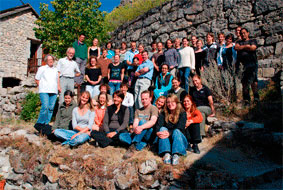
 A Long-Term Biodiversity, Ecosystem And Awareness Research Network
A Long-Term Biodiversity, Ecosystem And Awareness Research Network - Objectifs :
- ALTER-Net is a Network of Excellence of the 6th Framework Programme of the European Community. The ALTER-Net Mission is the integration of biodiversity research capacities across Europe to:
• Create a network for European long-term terrestrial and fresh-water biodiversity and ecosystem research;
• Assess and forecast changes in biodiversity, structure, functions and dynamics of ecosystems and their services; and
• Consider the socio-economic implications and public attitudes to biodiversity.
- Summary :
The summer school strived towards a balance between natural and social science aspects including policy processes. The aim was, besides the aspect of environmental awareness, the dissemination, and critical review of the approach of integrated assessment of vulnerable ecosystems and their services under global change exemplified by biodiversity.
The summer school presented the state-of-the-art of vulnerability assessment, including information on scenario techniques, ecosystem modeling approaches for selected ecosystem services and an intensive dialogue between the participants and the lecturers.
Target groups were graduate students and young scientists from environmental sciences and related disciplines as well as social sciences mainly from ALTER-Net partner institutes.
The 32 participants formed four working groups which each worked on a case study on the local region of the Var catchment on different sectors; i.e. water, agriculture, nature conservation and tourism. Two delegates from each group formed a synthesis group who summarized the results of the four case studies for policy-makers. The report was written as if it had been a project funded by the EU.
An excursion exemplified land-use change on the Plateau de Valensole, at the Lac de Ste. Croix and the Gorge du Verdon.
On the free day, hikes to the neighboring mountains or simply relaxation were mainly on the agenda.
One of the major goals for the summer school, the interaction between students and lecturers, was facilitated by the excursion and through the intensive tutorial and team work of the students which was attended by many lecturers in the afternoons.
- Wolfgang Cramer
-
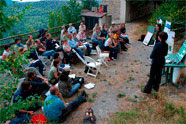
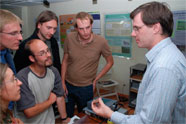

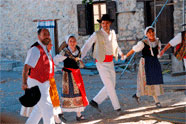 Poster sessionLively discussion after a presentationHike to visit the local shepherdArtemise, local dance group from Annot
Poster sessionLively discussion after a presentationHike to visit the local shepherdArtemise, local dance group from Annot
- Ecole d'été de Physique Non Linéaire
Organisateur :
Laboratoire de Physique des Solides - Université de Paris-Sud
Coordinateurs :
Alain Joets
Dates :
16 au 23 septembre 2007
Participants : Jean-Luc Beaumont, Yanne Chembo, Stéphane Chrétien, Paul Dely, Nadia Djellali, Rémy Dubertrand, Mohammad El Smaily, Abdou Karim Farota, Frédéric Faure, Jean-Marc Gambaudo, Remo Giust, Mariana Haragus, Pierre Inizan, Gérard Iooss, Maxime Jacquot, Guillaume James et épouse, Alain Joets, Laurent Larger, Stephane Métens, Elisabeth Pécou, Benjamin Pergolizzi, Kamel Saoudi, Arnd Scheel, Jonathan Touboul, Nathalie Tronko, Hamid Zahhrouni.
- Compte rendu :
Le but de l'Ecole est d'offrir une formation de base de haut niveau à de jeunes doctorants ou à des chercheurs désireux d'aborder des thématiques non-liéaires.
Par rapport aux années précédentes, le nombre des cours principaux a été accru, passant de 4 à 5, ce qui a permis d'enrichir notablement le contenu scientifique enseigné. En plus de l'enseignement de base sur les structures spatiales et temporelles, l'Ecole a proposé des thèmes assez variés :
• cours "Systèmes dynamiques" par E. Pécou, Université de Nice-Sophia Antipolis ;
• cours "Structures Spatiales et Morphogenèse" par S. Métens, Matière Systèmes Complexes, Paris VII ;
• cours "Stabilité des ondes non-linéaires" par M. Haragus, Lab. De Mathématiques, Besançon et A. Scheel, Université de Minneapolis) ;
• cours "Quasi-cristaux et systèmes dynamiques" par J.M. Gambaudo, Université de Nice-Sophia Antipolis ;
• cours "Chaos quantique" par F. Faure, Institut Fourier, Grenoble.
De plus, de nombreux participants ont exposé leurs travaux dans de petites séances de 20 à 30 minutes.
Notons que, comme l'année dernière, l'auditoire continue à s'élargir quant à l'origine géographique. L'Ecole a accueilli ses premiers participants d'Afrique du Nord (Algérie) et d'Afrique Noire (Sénégal).
De même, certains intervenants viennent de l'étranger, comme A. Scheel, professeur à l'Université de Minneapolis (Minnesota, USA).
A noter enfin qu'un ancien élève de Peyresq (F. Faure) revient cette année comme intervenant (Chaos Quantique).
Tout ceci montre assez bien la vitalité de l'Ecole.
-
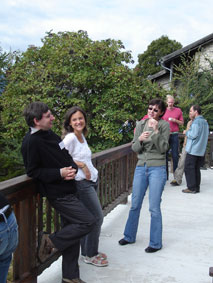 Professeur Alain Joets
Professeur Alain Joets